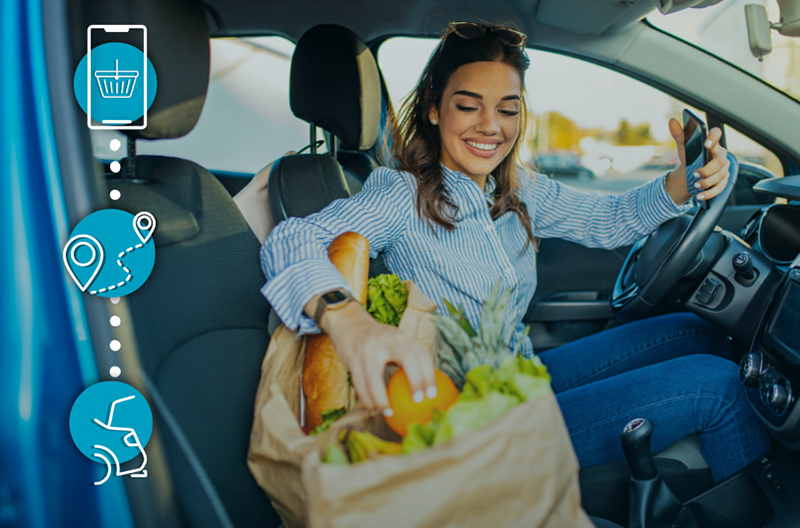Sponsored content

In inflationary times, grocery shoppers are looking to trim costs to manage their household budget. They still want convenience, but they’re willing to compromise to save a little money. It’s especially important to listen to your customers to ensure you provide the options they’re looking for now.
Recent Mercatus research (Omnichannel Shopper Behavior Report 2022, Vol. 1 fielded June 30-July 1 and Vol 2 fielded August 25-27, 2022) supplies key insights into shopper behaviors and the operational solutions that grocery retailers can activate to satisfy them.
Giving customers choice with e-grocery fulfillment fees
Our research showed the reason a grocery shopper would choose pickup over delivery is the lower service fees. That finding didn’t surprise us, as it had emerged in our previous research. But we also discovered shoppers would opt for next day or longer fulfillment if it meant they’d pay an even lower fee.
The omnichannel customer is looking for convenience, but not at any cost. Research has shown that 42 percent of customers would prefer to pay a reduced service fee and wait for next day, 2-day or longer delivery. Grocers who offer both pickup and delivery, as well as variable fee structure for their customers will win at omnichannel grocery.
This can have a positive financial impact for your customers as well as e-commerce operators. Grocers can not only offer cost effective fulfillment options, like pickup, but take advantage of the efficiencies that come with off-peak fulfillment. Allocation and effective use of in store labor can be done by batching out the pick, pack and staging of grocery orders, without having to scramble to assemble each order individually or with the immediacy that is required for quick serve delivery.
For pickup customers, convenience is key
It’s more than the fees associated with grocery services that matter to shoppers, there are other elements that contribute to a positive online grocery experience, including convenience. For example, our research found that the number two reason customers choose pickup is to avoid waiting at home for their delivery order to arrive.
This has significant implications. If customers choose Pickup for its greater convenience over delivery, your pickup experience must be smooth, efficient and fast to meet that expectation. We observed that as perceived wait times at the Pickup location increased, customer satisfaction decreased. (We used Net Promoter Score [NPS] to measure customer satisfaction.)
Additionally, your pickup service needs to hold up in comparison to other pickup services. Our research revealed that of the 60 percent of U.S. households that used pickup over the last year, 80 percent had experienced what it’s like to use either Walmart or Target’s service. That equates to one-half of all online grocery shoppers.
This is important because every experience a grocery shopper has at another retailer gives them one more point of comparison by which to judge your performance. You must view these retailers’ pickup services as direct competition and evaluate how your services stack up against them.
Listening to your customers helps your business
Fortunately, there are many operational solutions available — such as optimized picking methods and fulfillment technologies — that can minimize wait times. (At Mercatus, our benchmark is two minutes or less.)
Providing an app so customers can announce their arrival or use geolocation tracking to signal their proximity to your pickup area is another way to generate a faster, smoother pickup experience and higher satisfaction levels. We observed that using a mobile app at check-in correlated with a much stronger NPS and customer satisfaction.
Research revealed that grocery shoppers are a pretty tech savvy bunch. Nearly 50 percent used the retailer’s app to communicate to the store their arrival at the designated pickup location. They weren’t shy about sharing their location through the app either.
However, it seems that the current advantage for mass retailers is that grocery shoppers were far less likely than mass customers to use a retailer app. Clearly there’s a huge opportunity here for regional grocers to adopt mobile technologies that will improve the pickup experience at their stores.
Let shopper behavior inform your e-grocery strategy
Understanding shopper behavior, preferences and overall experience is crucial to customer retention and omnichannel success. Regional grocers need a strategy that makes operational sense and aligns with the needs of their customer. At Mercatus, we are committed to providing regional grocers a path to omnichannel profitability with solutions that not only meet operational needs, but delight the customer.
An easy way to understand today’s grocery customer is to download the Omnichannel Shopper Behavior Report 2022. Volume 3 exploring the importance of a positive customer experience is out now.
For more technology news from The Shelby Report, click here.

